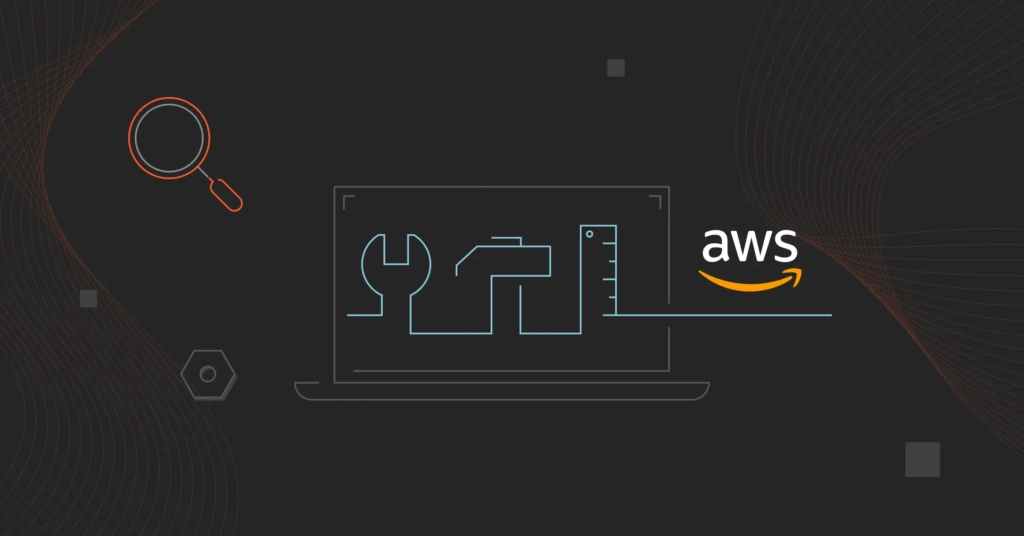Amazon Web Services (AWS) is a great platform for DevOps and FinOps teams for several reasons. It provides a wide range of services, supports extensive automation, and includes strong collaboration tools.
Despite this, AWS can be a complex ecosystem that makes cloud management challenging.
The good news is that AWS also offers a suite of tools to help you apply DevOps best practices and cloud cost optimization. In this guide, we’ll go over some of the best AWS tools for DevOps and FinOps teams to consider immediately.
What Types Of AWS Tools Are There?
AWS offers an extensive variety of tools. As of the time of publishing this post, AWS offered over 240 products and services. These offerings cover most bases across multiple industries and use cases.
For this post, we’ll narrow focus to DevOps and FinOps implementation.
What To Consider Before Choosing Your Next AWS Tool
Switching tools fairly often because they no longer deliver is time-consuming and something we’d rather avoid. If that’s true of your team as well, it will be worth your time to consider the following.
Precise visibility and reporting
For FinOps, pick a tool that delivers granular, immediately actionable insights such as cost per individual customer, software feature, product, or dev team.
For DevOps, seek a tool that offers root cause analysis, real-time monitoring, and customizable dashboards. These will help you pinpoint the source of issues and organize your visibility to minimize unnecessary downtime.
Full allocation and tagging
You want a tool that provides a complete picture of your environment, costs, performance, and more. That requires 100% allocation. Remember, incomplete information can be more misleading (and very expensive) than no information at all.
Likewise, an ideal FinOps tool will support granular tagging, accurately allocating costs to specific projects, departments, or teams. By identifying cost drivers, you can tell where to make changes to optimize performance, security, and costs.
Anomaly detection and alerting
Invest in a tool that detects unusual patterns and anomalies using machine learning algorithms. It should provide automated alerts and recommendations. You want to be able to quickly identify and address cost concerns or architectural inefficiencies before they become big problems.
Integration and automation
Confirm that the tool integrates seamlessly with your existing AWS services and other tools in your environment. For DevOps, this might include CI/CD pipelines and monitoring systems. For FinOps, integration with your favorite cloud cost management and accounting tools is crucial.
Support and documentation
Search for tools with a strong community, extensive documentation, and responsive support. It’s a big deal. Consider CloudZero customers who get ongoing consultations with human FinOps Certified Practitioners. These customers say CloudZero pays for itself within three months.
Scalability
You want a tool that’ll handle your organization’s scale efficiently. Whether that’s scaling up to manage increased workloads or scaling down to optimize costs. You can schedule a demo to evaluate how well it supports dynamic environments and growth.
Automation and efficiency
For DevOps, this may look like deployment automation, infrastructure as code, and configuration management. FinOps automation might involve automated alerts for budget thresholds or cost anomalies. Or, it might be automating actions such as powering down or terminating further resource usage when the threshold is met.
Security and compliance
Explore the tool to discover what standard and unique security measures it offers. Remember, it costs over $4.5 million to resolve a single data breach, according to a recent IBM survey. Capabilities to check off here include encryption, access controls, and compliance with standards such as GDPR or HIPAA. It should provide secure access and auditing tools.
Shortlist Of Native AWS Tools For DevOps
AWS offers several services designed specifically for DevOps practices, including AWS CodePipeline, CodeBuild, and CodeDeploy. For example, your team can use these tools for Continuous Integration and Delivery (CI/CD), automating software releases to improve efficiency.
1. AWS Catalyst
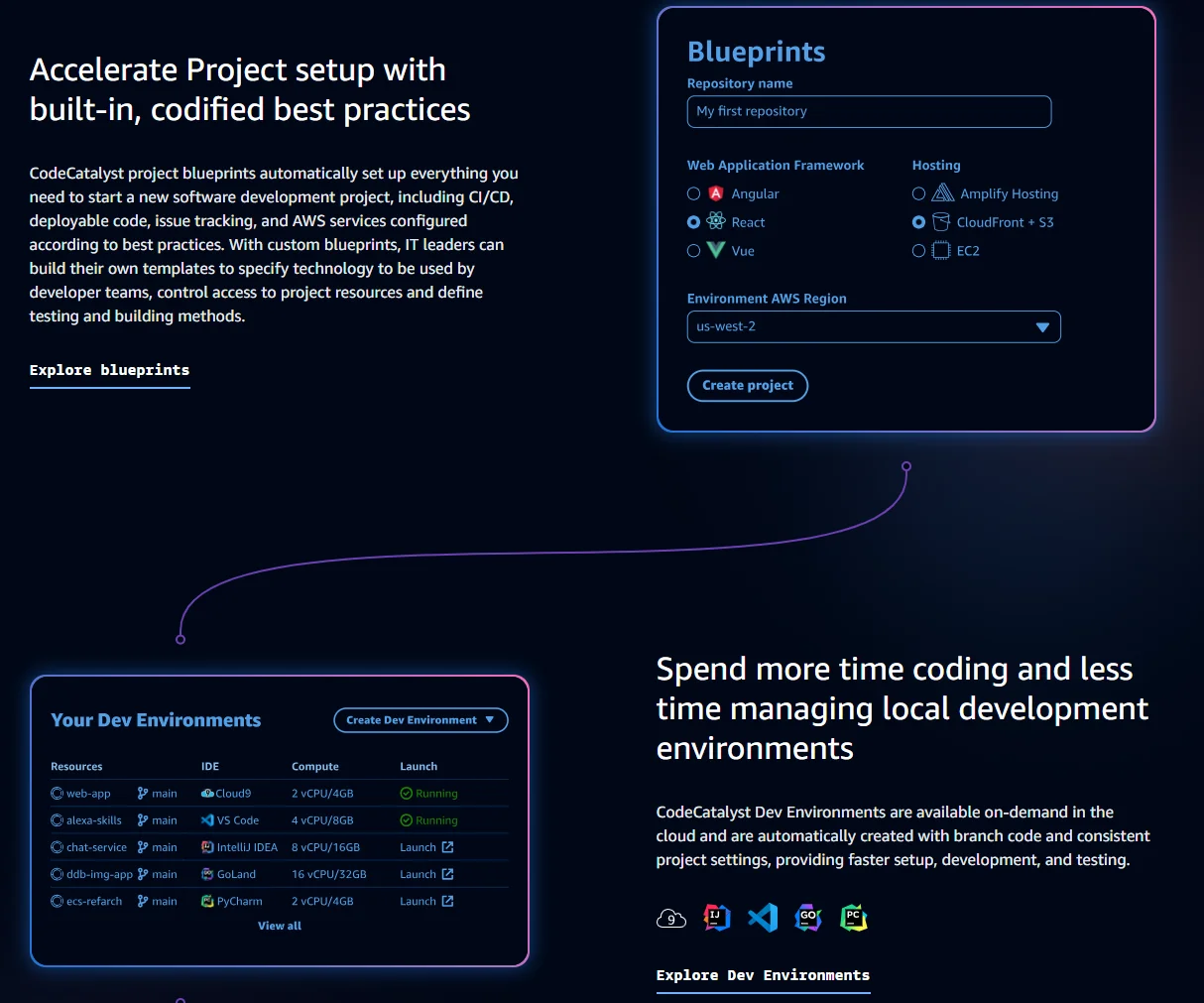
In July 2024, AWS discontinued support for AWS CodeStar, which provided a preconfigured environment for building, managing, and releasing code. AWS CodeStar Connections (now AWS CodeConnections) is not affected.
In its place, AWS CodeCatalyst provides a more extensive way to develop code, track your dev projects, as well as test and deploy applications on AWS.
Automatically created CodeCatalyst Dev Environments come with pre-installed dependencies (project templates). In addition, CodeCatalyst integrates seamlessly with repos such as GitHub and GitHub Actions.
This ensures you can get started on your first or existing project without delays.
You are free to use your favorite supported IDE (IntelliJ IDEA, AWS Cloud9, PyCharm, etc) from any device, anywhere. You can then launch your cloud dev environment from CodeCatalyst or directly from your favorite IDE.
You also get CodeWhisperer, an AI companion trained extensively to use your comments and existing code to generate code suggestions. This includes snippets to entire functions in real-time.
CodeCatalyst also helps you switch between projects, branches, or repositories with a single click. Ultimately, you are free to modify your compute, memory, and storage however you choose.
2. AWS CodeBuild

CodeBuild provides a fully managed continuous integration service on AWS. This means you don’t have to provision, scale, and manage your own build servers. You only need to specify your source code’s location and your build settings. CodeBuild then runs the scripts that compile, test, and package your code.
For further ease your work, CodeBuild can be event-triggered (by code commits). This enables automated builds whenever changes occur.
Better, CodeBuild fosters flexibility by supporting a variety of build tools, such as Gradle and Apache Maven, as well as several programming languages. And is often the case on AWS, the tool scales automatically to handle spikes in build requests.
3. AWS CodeDeploy
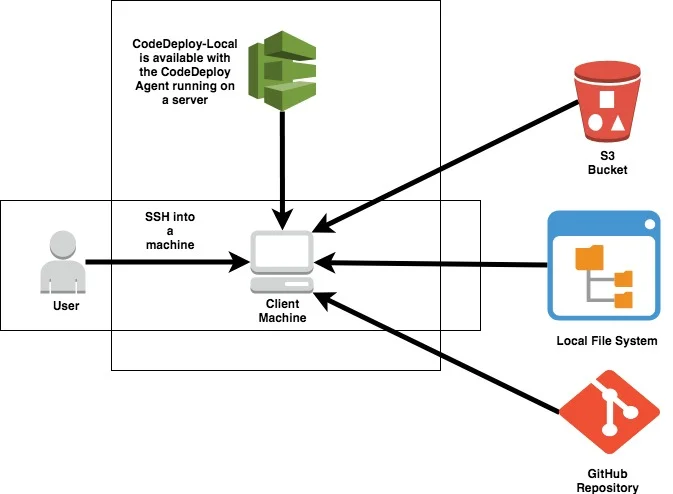
CodeDeploy automates application deployments to compute services such as Amazon EC2 (instances), AWS Lambda (functions), and your own instances (on-premises or private cloud servers). You can also deploy to Amazon Elastic Container Service (ECS).
The tool simplifies deployments from your favorite source code repository, such as GitHub or BitBucket or the Amazon S3 service. Notably, you can also execute In-place and Blue-Green deployments across multiple hosts with diverse configurations. And this is great for hybrid cloud setups.
CodeDeploy also offers granular control over the process. This includes lifecycle hooks that trigger actions at different deployment stages.
4. AWS CodePipeline
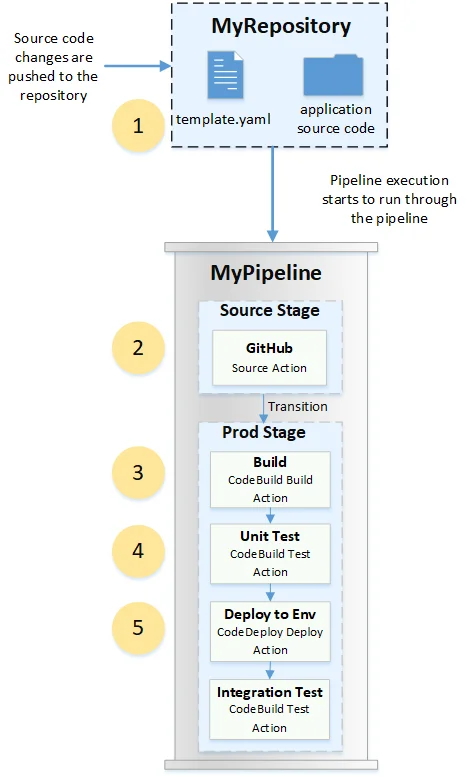
CodePipeline is designed to automate the steps for releasing software. The continuous delivery service (CD) helps you model, visualize, and configure these stages of the release process. AWS CodePipeline then orchestrates the flow of work from source code retrieval through the build and test phases of your deployment.
It supports parallel execution, custom and pre-built plugins, and lets you use a declarative JSON document to define your pipeline structure. With CodePipeline, you can pull your code directly from CodeCommit, Amazon S3, Amazon ECR, GitHub.
You can also run unit tests and builds in CodeBuild. The tool also deploys changes to your CodeDeploy, Elastic BeanStalk, Fargate, Amazon ECS. In addition, you can use Lambda to trigger code-defined custom functions at any stage of a pipeline.
5. Amazon ECS
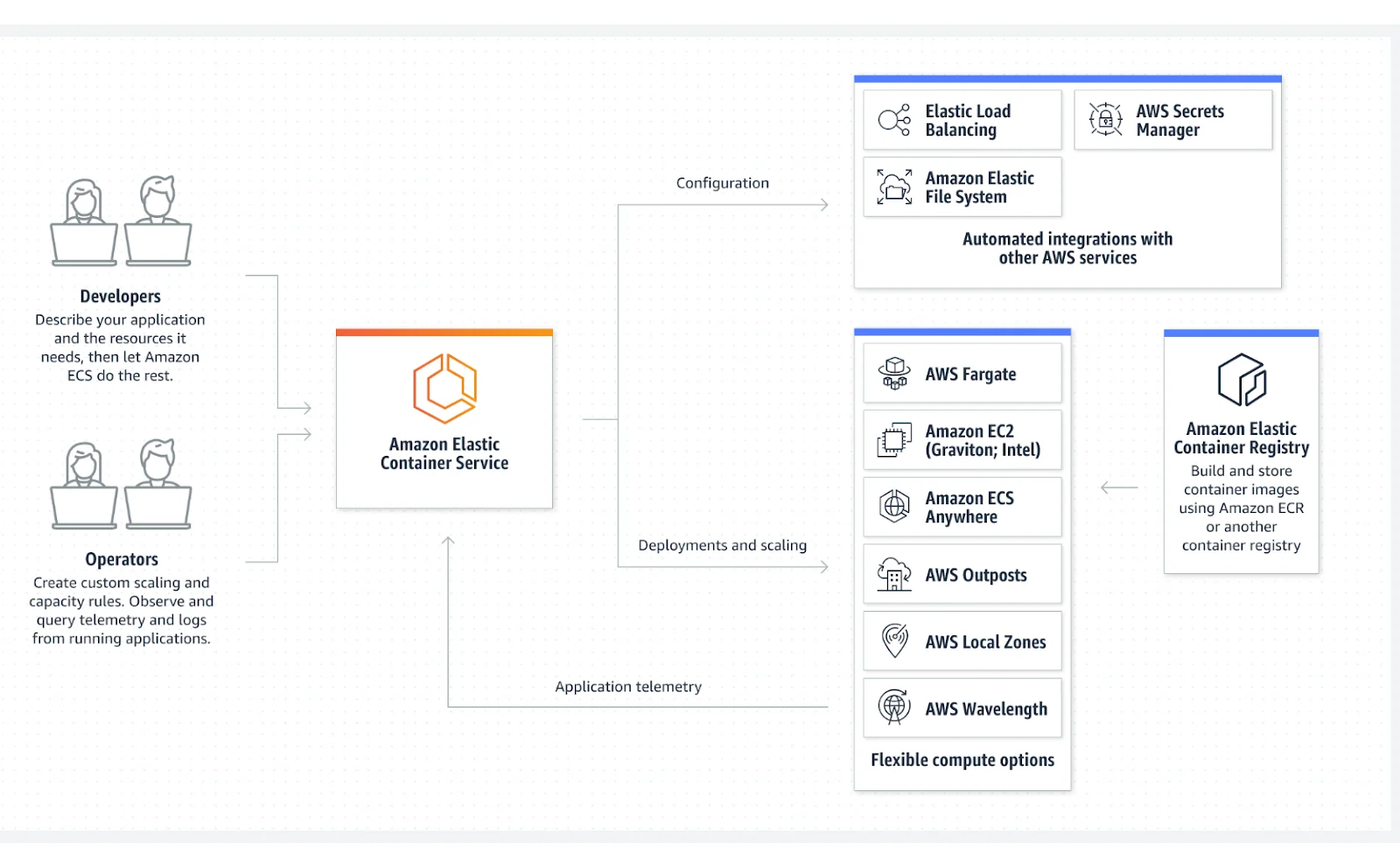
The Amazon Elastic Container Service is ideal if you need an AWS native container orchestration service for Docker containers. More specifically, Amazon ECS simplifies the process of managing infrastructure for containerized applications as a fully managed service (than say, upstream Kubernetes).
If you aren’t using Docker images, you’ll want to explore Amazon Elastic Kubernetes Service (Amazon EKS) to manage Kubernete-based containers.
That said, Amazon ECS is user-friendly, highly scalable, and is itself free; you pay for the underlying resources consumed.
There’s more. If you want to go serverless here, ECS works seamlessly with AWS Fargate for just that. Amazon ECS on Fargate further simplifies resource provisioning. It also automates scaling based on demand and isolates workloads to improve security. This also means you can optimize costs by paying only for the resources you need. And speaking of Fargate…
6. AWS Fargate
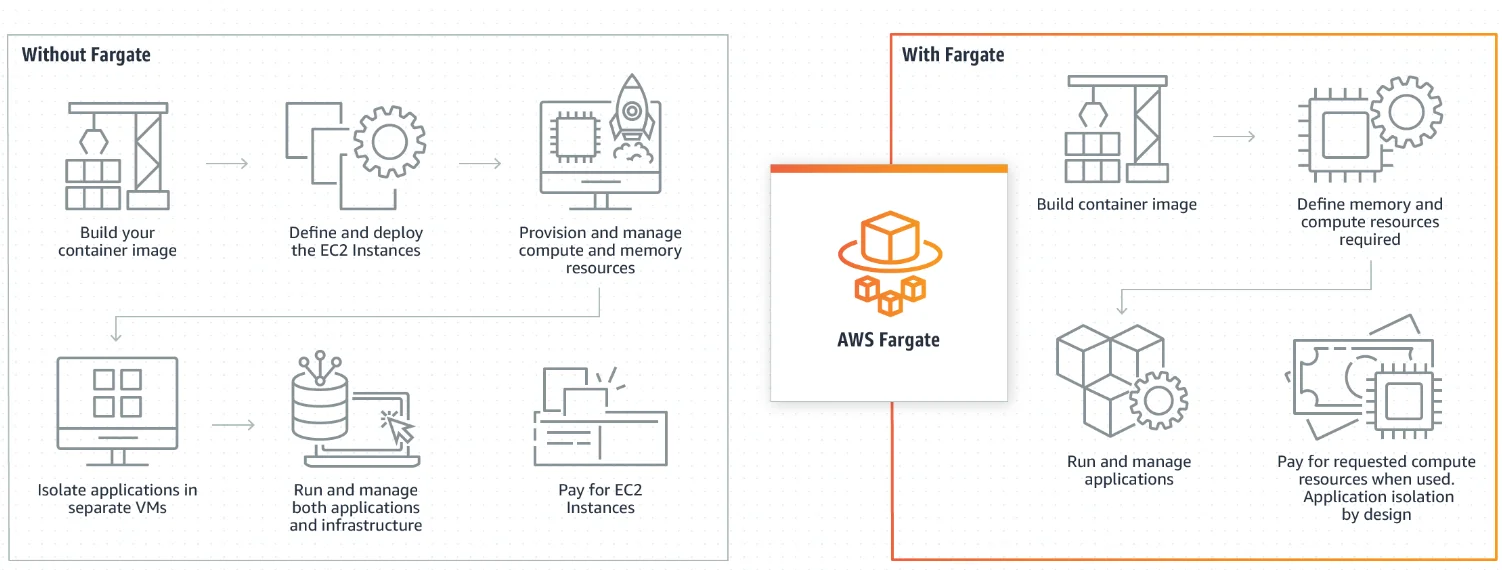
AWS Fargate is a serverless compute engine native to the AWS cloud. It automatically provisions, scales, and manages the underlying infrastructure. It also works seamlessly with both Amazon ECS and Amazon EKS for container management.
This frees your DevOps teams to build applications instead of managing servers. You specify container requirements, and AWS Fargate handles the rest.
For FinOps teams, Fargate automatically adjusts capacity to maintain steady performance at the lowest cost, ensuring cost efficiency without sacrificing performance.
By minimizing overprovisioning or underutilizing infrastructure, you get to pay for what you actually use.
7. AWS Lambda
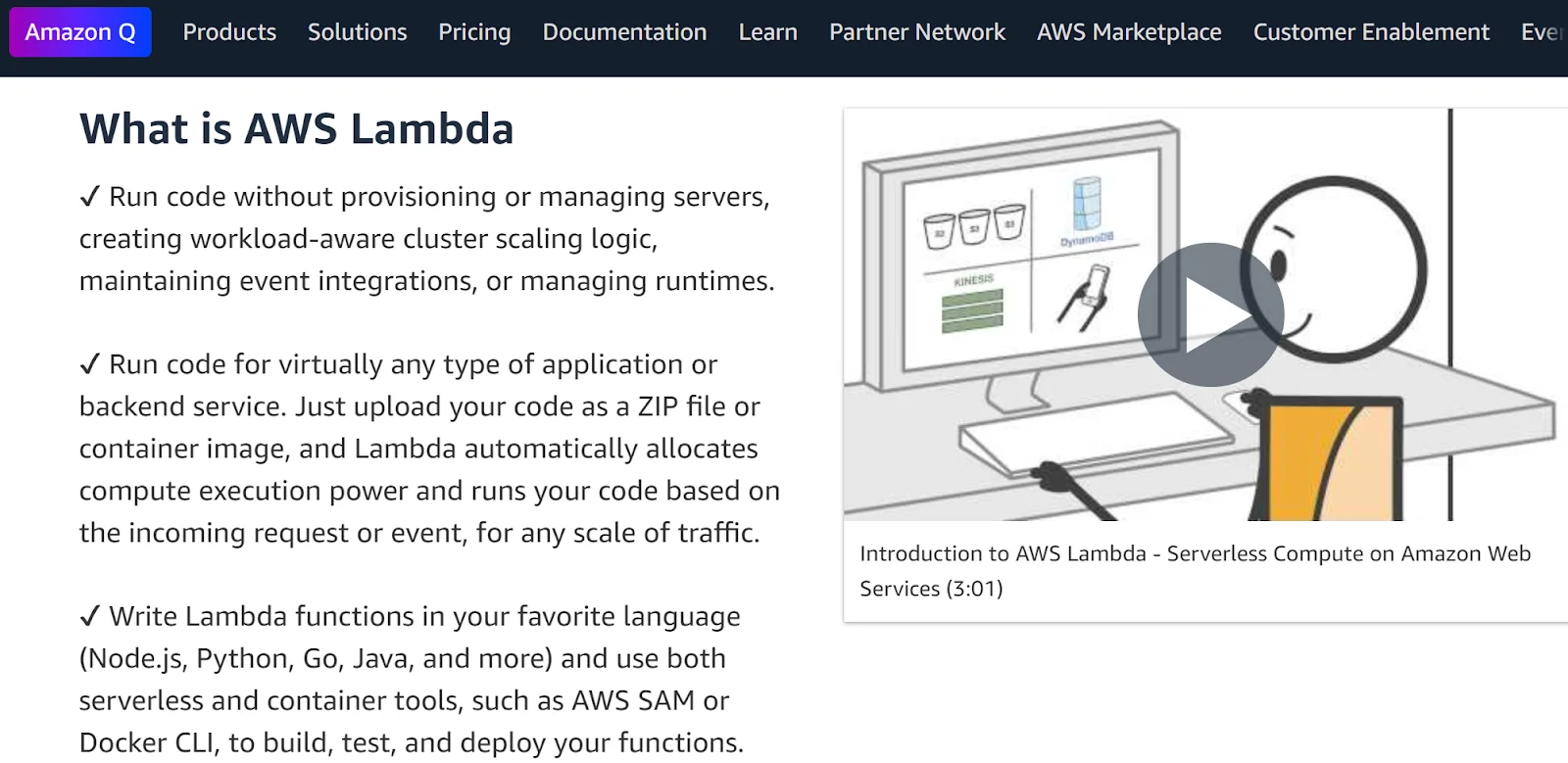
Like AWS Fargate, AWS Lambda is a serverless compute service. However, AWS Lambda is designed to execute code in response to events. It runs code for virtually any type of backend service or application.
Lambda does this automatically, so you don’t have to worry about managing underlying infrastructure for optimal performance and costs.
In addition, Lambda supports multiple programming languages and runtimes, including Node.js, Python, Java, Go, and .NET Core, enabling DevOps to use their preferred tools.
For FinOps practitioners, you only pay for compute time consumed, billed in 100 millisecond increments. It minimizes waste since you only pay for what you need.
8. Amazon EKS
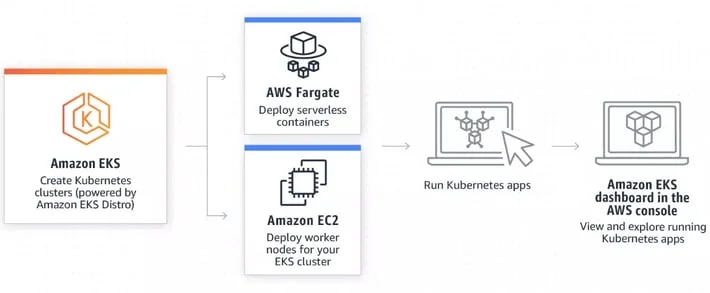
If you want to use Kubernetes containers on AWS, you’ll want to use the Amazon Elastic Kubernetes Service (Amazon EKS). As we mentioned earlier, Amazon ECS was built primarily to handle Docker-based containers.
With Amazon EKS, you get a fully managed Kubernetes orchestration service right on the AWS platform. Expect a user-friendly interface, compared to upstream Kubernetes, which can be quite a handful to manage.
EKS handles all your Kubernetes control plane admin tasks. That includes patching, upgrades, replacing unhealthy instances, and optimizing security configurations. It also enables you to scale your K8s containers across multiple AWS Availability Zones.
Ultimately, Amazon EKS uses a pay-as-you-go pricing model. This is great for organizations that want to pay for only the resources they use. See our in-depth Amazon EKS pricing guide here for more EKS cost optimization tips.
9. AWS GuardDuty
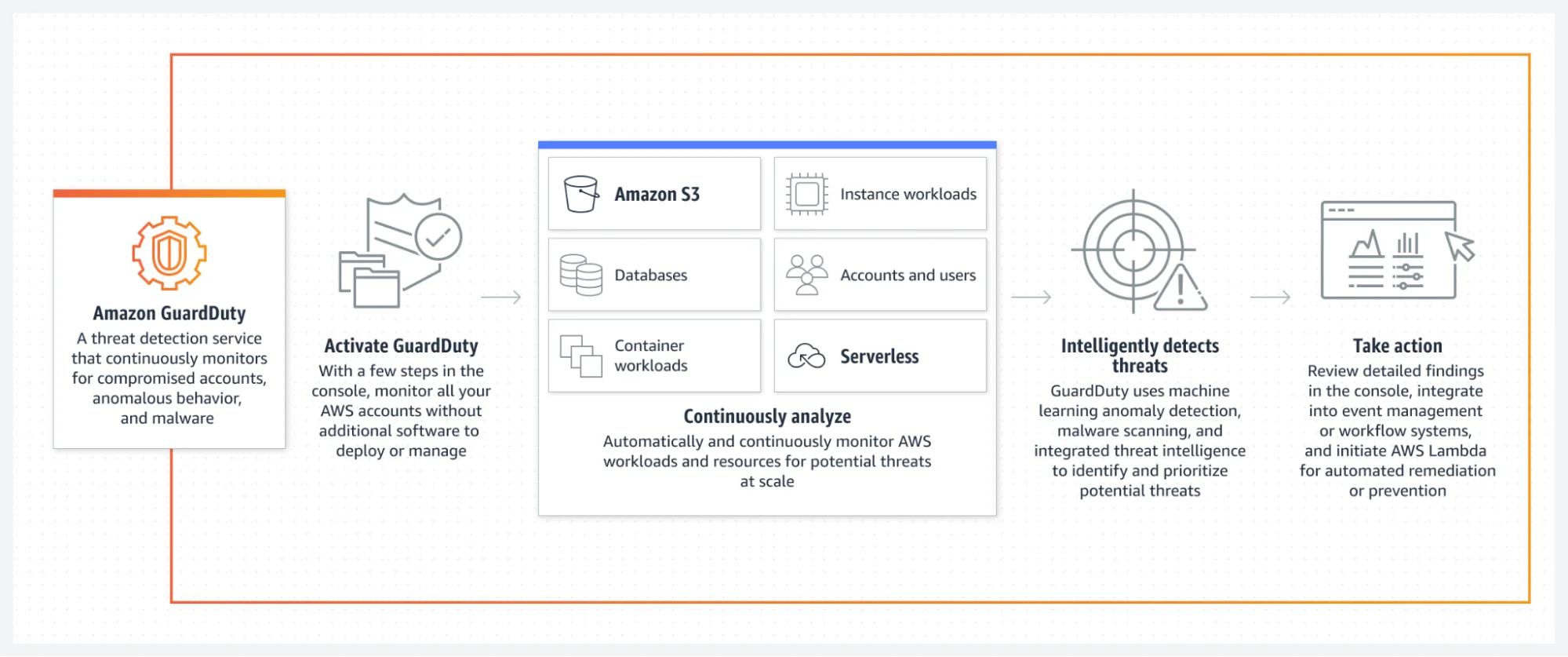
Amazon GuardDuty is a fully managed, account-level threat detection service that works across various AWS services. It runs continuously, monitoring AWS accounts, data, and workloads for malicious activity and unauthorized behavior.
GuardDuty uses machine learning, anomaly detection, and scalable threat analysis to analyze multiple data sources. These sources include AWS CloudTrail logs, VPC Flow Logs, and DNS logs.
Examples of threats you can catch here include compromised credentials, data exfiltration, and unusual API calls. Amazon GuardDuty also generates actionable security findings, enabling your DevOps and FinOps teams to respond quickly and avoid costly incidents.
These native AWS tools can help you keep your AWS environment working as it should, whether you’re just starting or need to keep your existing environment fully operational.
Common Third-Party AWS Tools For DevOps
Even so, your needs may evolve and grow to the point where native AWS services may not be able to provide the level of intelligence you need for effective cloud management. If that’s the case, here are some of the best AWS tools for teams looking for more.
10. GitLab
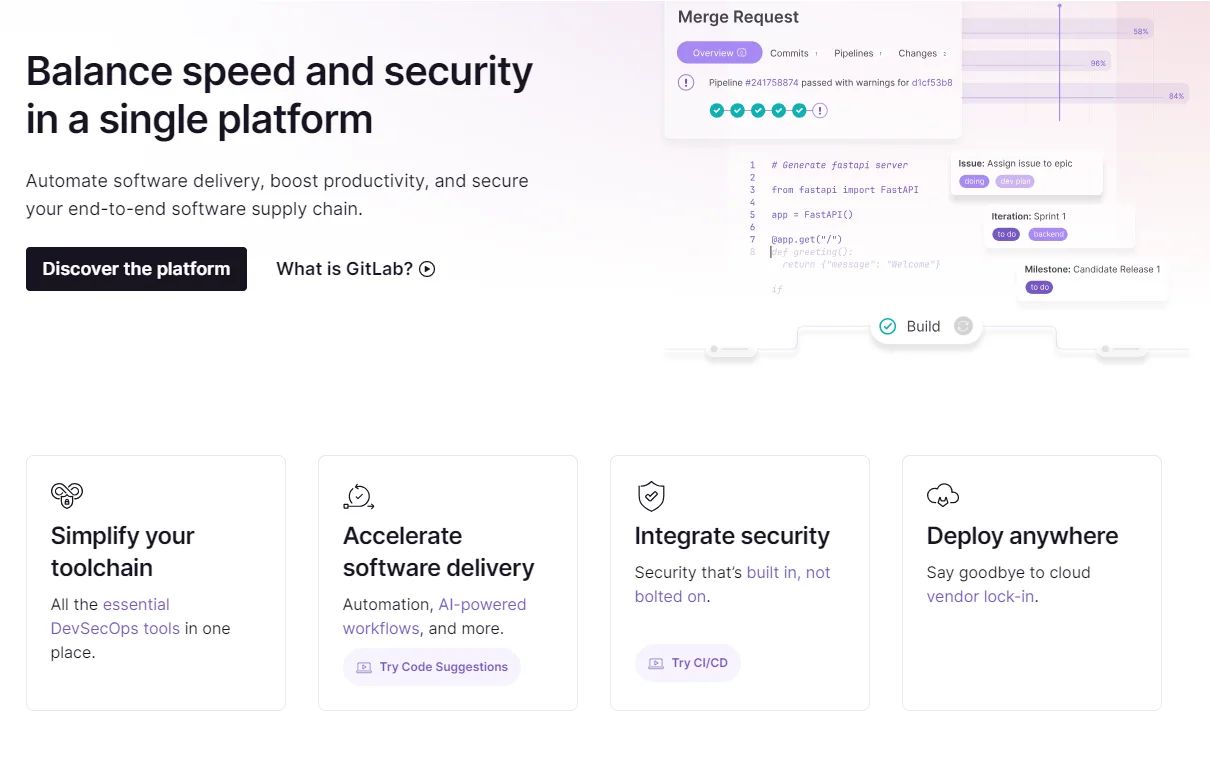
GitLab is a top alternative to GitHub and BitBucket, two of the most popular Git-based source code repositories today. GitLab is unique in that it goes all out beyond source code management to being a full-on DevSecOps platform.
It supports automated software delivery (CI/CD), project management (monitoring and analytics), and security and compliance. This comprehensive approach streamlines workflows, reducing the need for multiple tools.
You can also host open, free, and private repositories on GitLab. Better yet, its free tier supports unlimited private repositories. This makes GitLab an attractive choice for teams needing privacy without incurring costs. Additionally, GitLab offers self-hosting options, providing your DevOps and FinOps teams with greater control over their data and security.
11. Kubernetes

K8s, short for Kubernetes, is the most popular container orchestration platform today – and a top alternative to Docker Swarm. It is particularly popular for its self-healing, high scalability (horizontal scaling), and open-source design.
Being open-source means your DevOps team can more easily add custom tools to it to suit your needs. Additionally, you can define the desired state of your applications, and Kubernetes will automatically manage changes. This helps make rollouts and rollbacks straightforward.
Its scalability is also great for organizations running up to 5,000 nodes, which is a higher number than say, Docker Swarm, handles.
Additionally, unlike Amazon ECS or EKS, Kubernetes helps prevent vendor lock-in. That’s because K8s works on-premises and across public, private, hybrid, and multicloud environments.
Ultimately, the large and active Kubernetes community helps keep the platform up-to-date and robust.
12. CircleCI
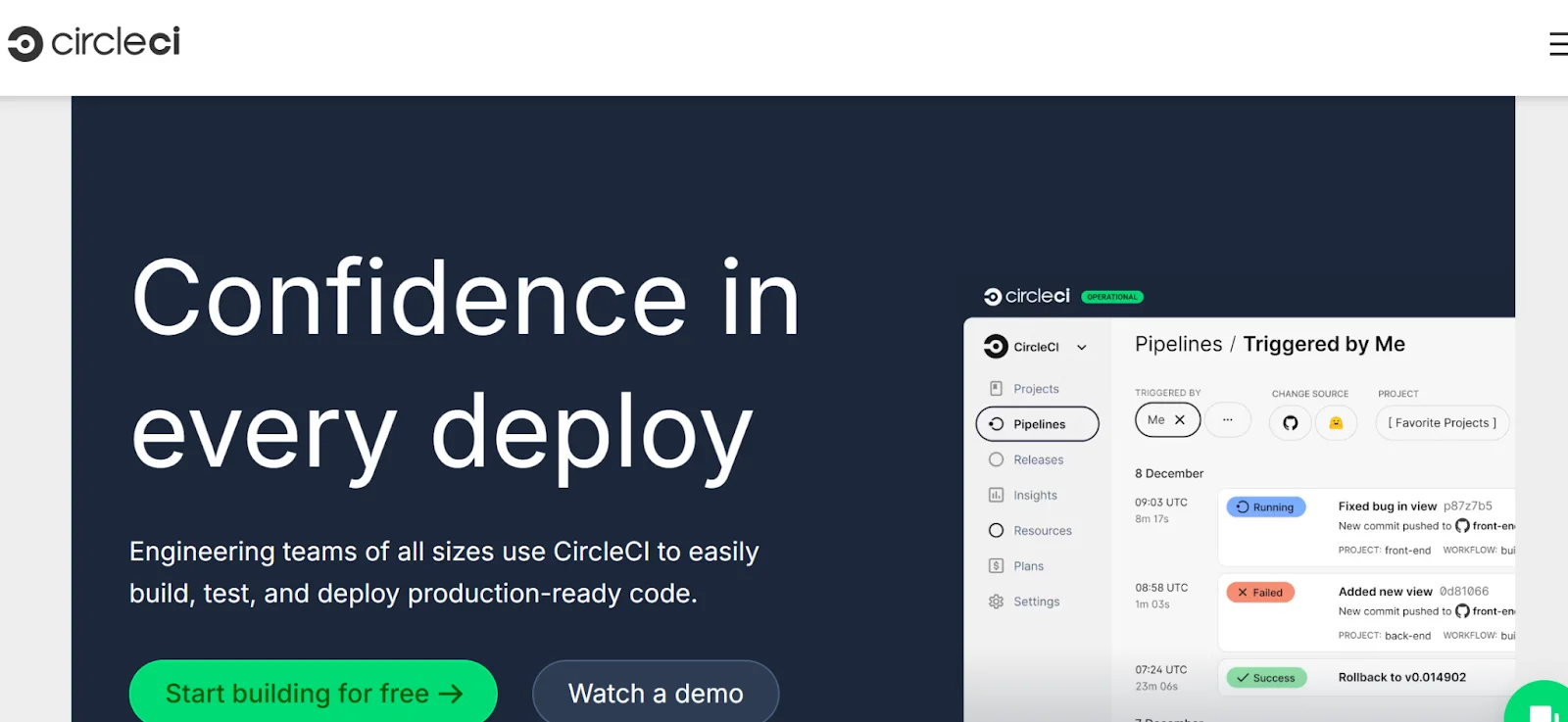
CircleCI is a comprehensive CI/CD platform that runs jobs in the cloud or on-premises (Linux, Windows, macOS). It is a DevOps must-have for its integrated CI/CD workflow, supporting seamless automation throughout the code commits to production process.
You define your CI/CD processes in a single YAML file, and CircleCI optimizes version control and collaboration aspects. Its Insights Dashboard also offers real-time analytics on build performance, ensuring you know what’s going on in your pipeline to streamline things.
CircleCI also supports “orbs”. These are reusable configuration packages that simplify setting up and promoting DevOps best practices across projects. For FinOps teams, the platform lets you customize resource allocation and concurrency settings, balancing optimal build times and costs.
13. Docker

Docker remains one of the most important DevOps platforms for teams deploying containerized applications to AWS (despite Kubernetes’ growth). To begin with, Docker provides a lightweight environment for building, managing, and scaling Docker containers.
Its components make it quite a complete DevOps platform as well. Docker components include Docker Engine (runtime system, Rest API), Docker Swarm (container orchestration), Docker Images (immutable, read-only), Dockerfile (image-building instructions/scripts), Docker Hub (image repository), Docker containers (operational images), and Docker Compose (coordination).
Additionally, Docker’s ability to scale up and down on demand helps optimize costs. Plus, CI/CD folks will love that Docker is built to support building, testing, and managing containerized applications throughout a CI/CD pipeline.
14. New Relic
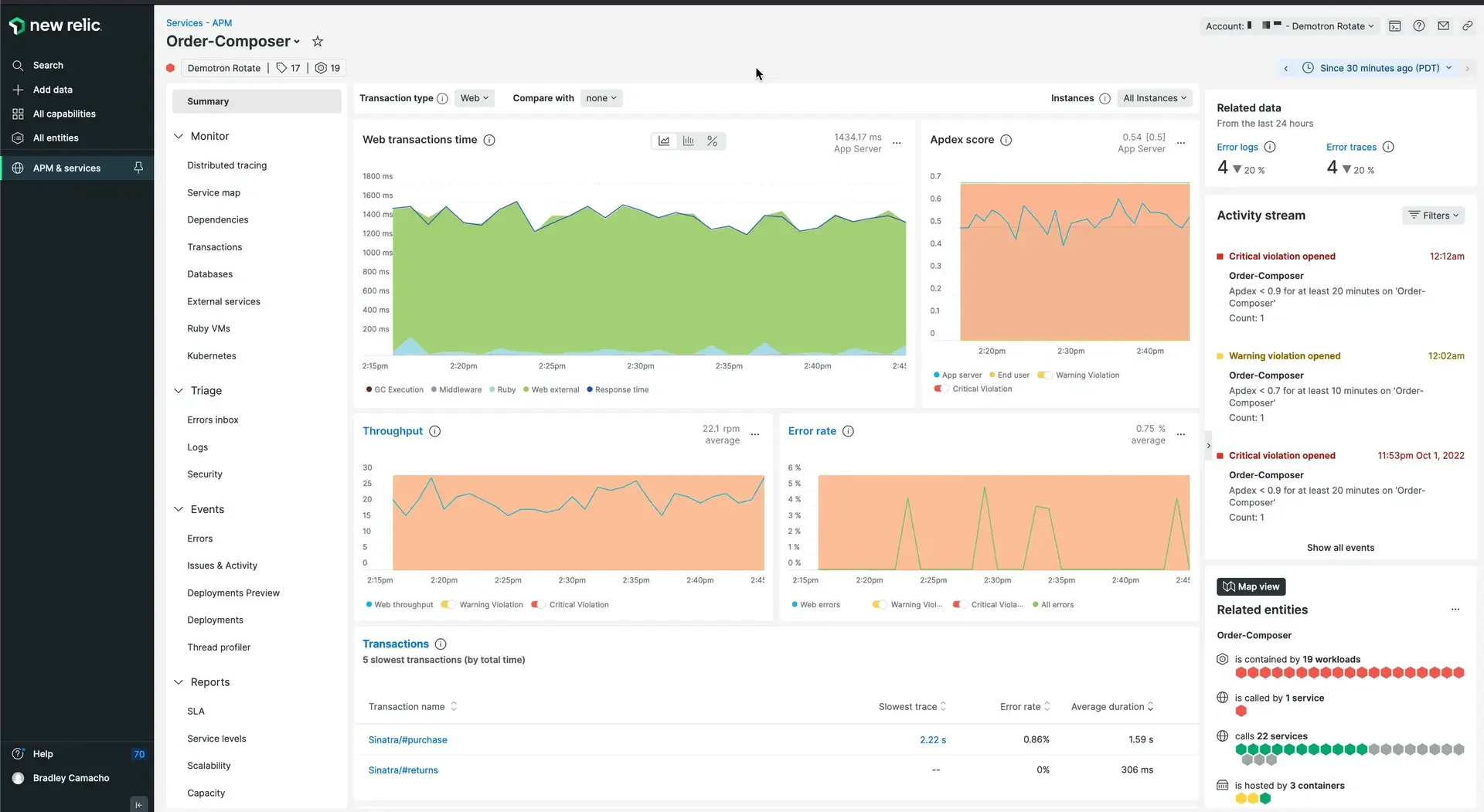
It’s true that AWS offers a decent set of continuous monitoring tools. If you need more robust real-time monitoring insights, anomaly detection, and security posture analysis, consider tools like New Relic.
The New Relic observability platform provides enterprise-level monitoring and reporting with advanced root cause analysis capabilities. Its full-stack monitoring capabilities cover metrics, logs, events, and traces. This means you can track performance, security, and cost insights to prevent bottlenecks and budget overruns all in one platform.
15. Splunk
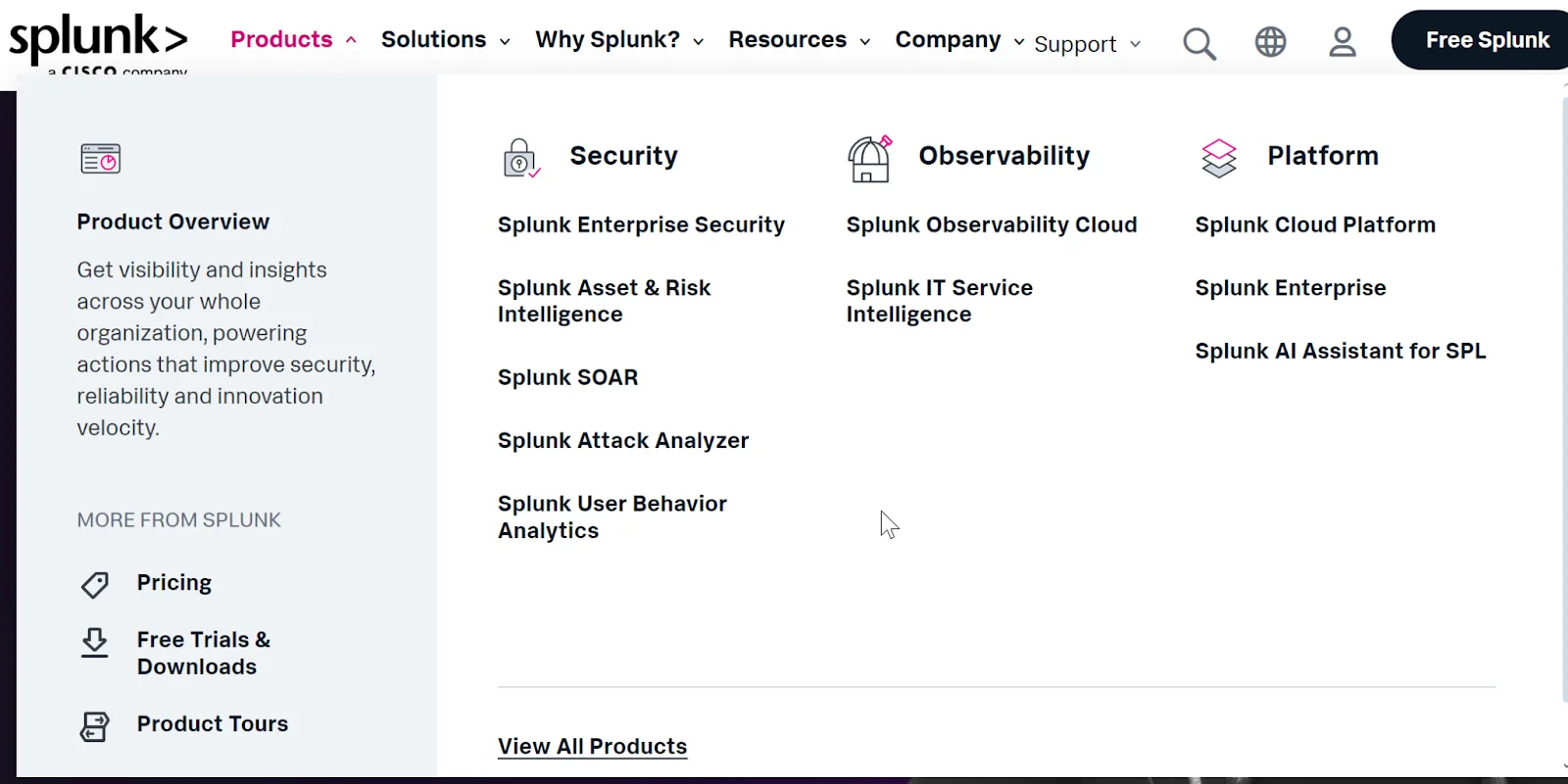
Like New Relic, Splunk is a full-stack observability platform that supports real-time monitoring. However, Splunk emphasizes security and threat detection, supporting SOAR and thorough User behavior analysis.
Splunk also provides powerful data ingestion. It can ingest data from a wide variety of sources such as logs, metrics, and events across on-premises, the AWS public cloud, multi-cloud, hybrid cloud, and private cloud environments.
This also powers context and workflows, which are not only great for sharing in-depth data but also interpreting and taking action based on a full picture of your AWS environment.
16. Jenkins
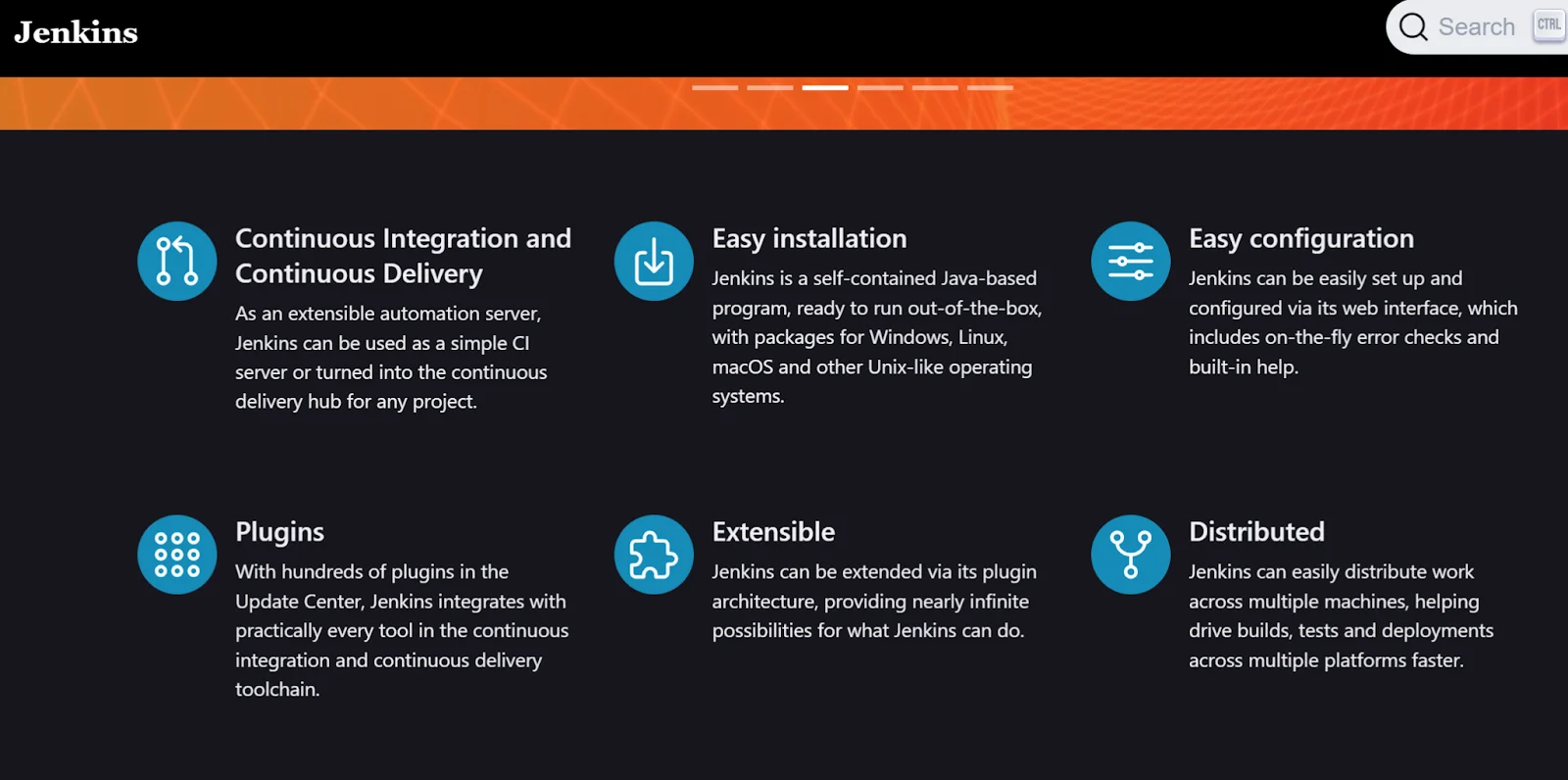
If you’re looking for a CI/CD platform for any size of AWS environment, Jenkins may be a good option. Jenkins is best known as an automation server for teams that want to build, test, and deploy applications at scale using a server-based system.
Jenkins provides a user-friendly way to set it up. It also distributes work across multiple instances (machines), boosting efficiency across multiple platforms. And Jenkins has been around for years, making it an assuring choices for critical deployments.
In addition, Jenkins has a robust community, which is great for getting help and custom tools (over 2,000 plugins available).
17. Puppet
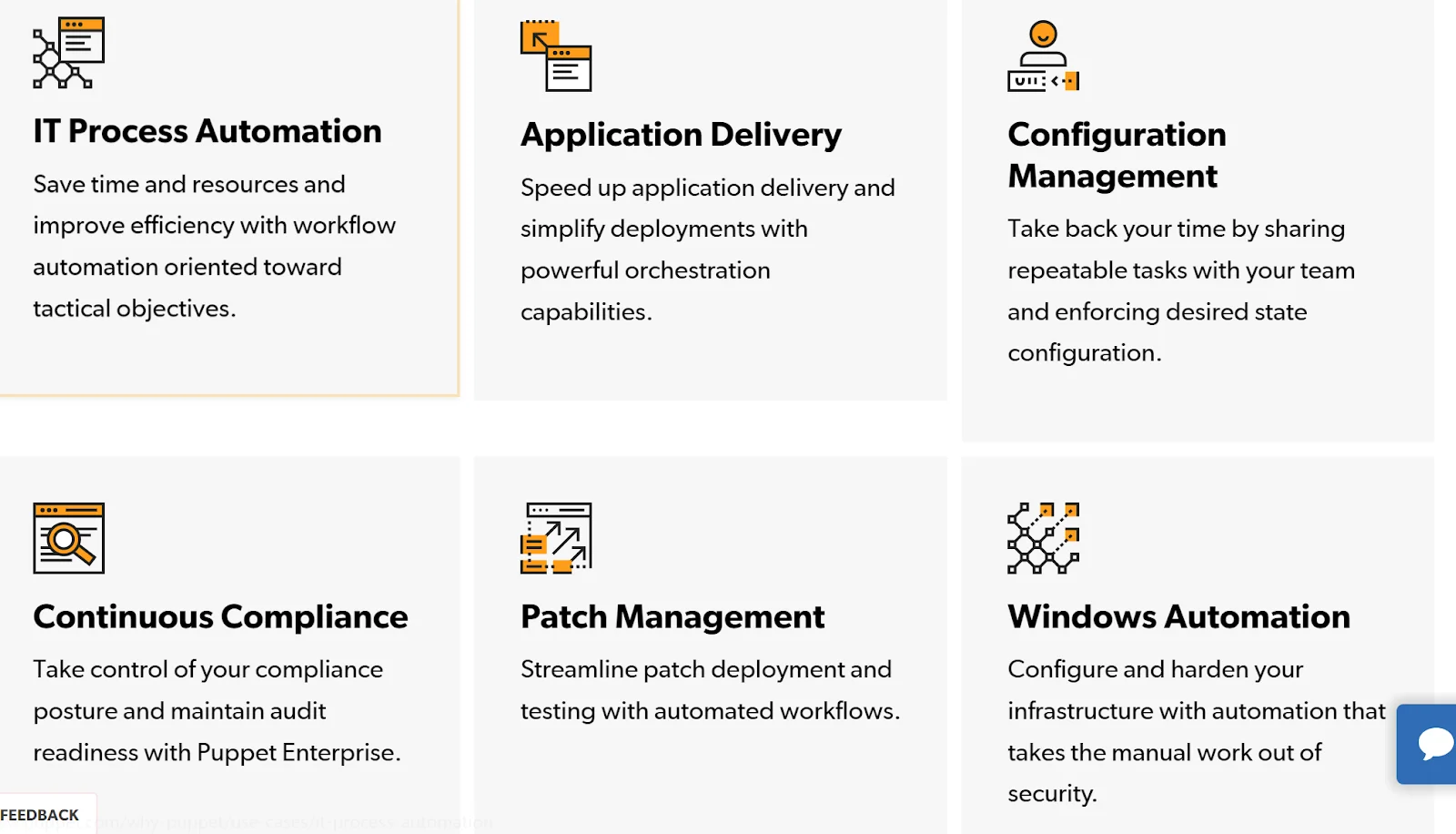
Puppet is a popular configuration management platform for DevOps teams. You can use it to automate and streamline infrastructure management for your DevOps projects. It is open-source, although there are also Enterprise and Puppet Enterprise Advanced editions.
The open-source edition lets you discover your resources in minutes, eases provisioning new nodes in cloud, on-premises, and hybrid environments, and orchestrates events and changes across node clusters.
You can also use Puppet for your software delivery needs.
Puppet is reliable, runs in Linux and Windows environments, and offers over 7,000 pre-built modules via the Puppet Forge library.
18. Travis CI

Travis CI offers deep and seamless integration with GitHub. The CI platform automatically detects changes in pull requests and triggers a build. Travis CI also delivers many other capabilities. These include automated tests and code coverage reports.
You’ll also like its straightforward setup for GitHub repositories. You use a .travis.yml file for configuration, which is generally easy to understand and set up.
Additionally, Travis CI provides free CI/CD services for open-source projects. You also get free build minutes for open-source projects, great for teams on budgets.
The build matrix feature enables you to test your code against multiple versions of languages and dependencies in parallel. This comes in handy for guaranteeing compatibility across different environments.
Additionally, you can opt for the hosted Travis CI service, which handles infrastructure management, simplifying setups and maintenance compared to the self-hosted solution.
In the next section, we will examine the best FinOps tools on AWS for teams looking to balance performance and cost efficiency.
Most Popular Native AWS Tools For FinOps Teams
The following AWS FinOps can be a great starting point for those just starting out or who do not have complex cloud cost optimization needs.
19. AWS Cost Explorer
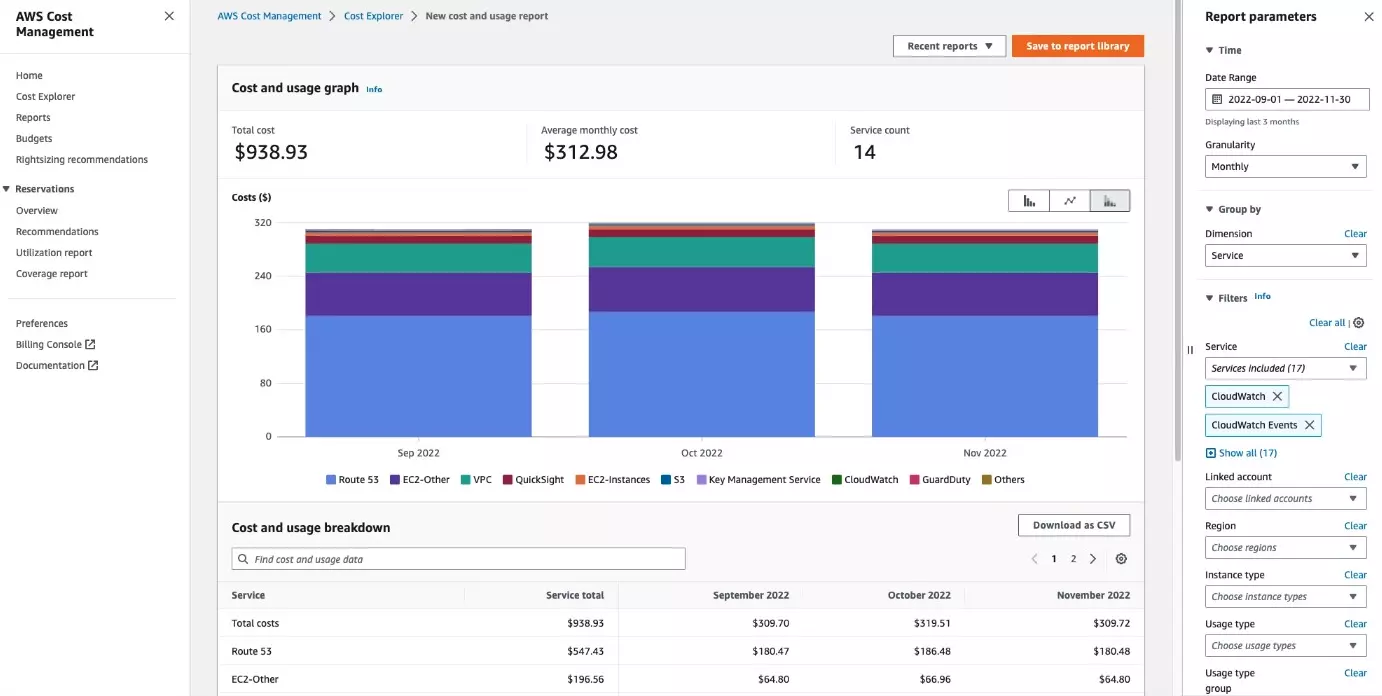
With Cost Explorer, you can monitor your usage over time and analyze associated costs. You can view your current month’s cost and usage data, as well as the previous 12 months’ as you rack up more data. For long-term analysis, the tool offers up to 38 months’ worth of historical data.
You can also generate forecasts for the next 12 months for planning. On the right of the image above, you’ll notice Cost Explorer offers multiple filters you can use to break down your cost and usage report – beyond the total and average costs.
AWS Cost Explorer also provides daily cost and usage reports at the resource level for all services. However, you can only analyze your cost and usage at the hourly granularity for just 14 days. Additionally, you’ll get reports about once every 24 hours, not hourly.
20. AWS Cost and Usage Reports
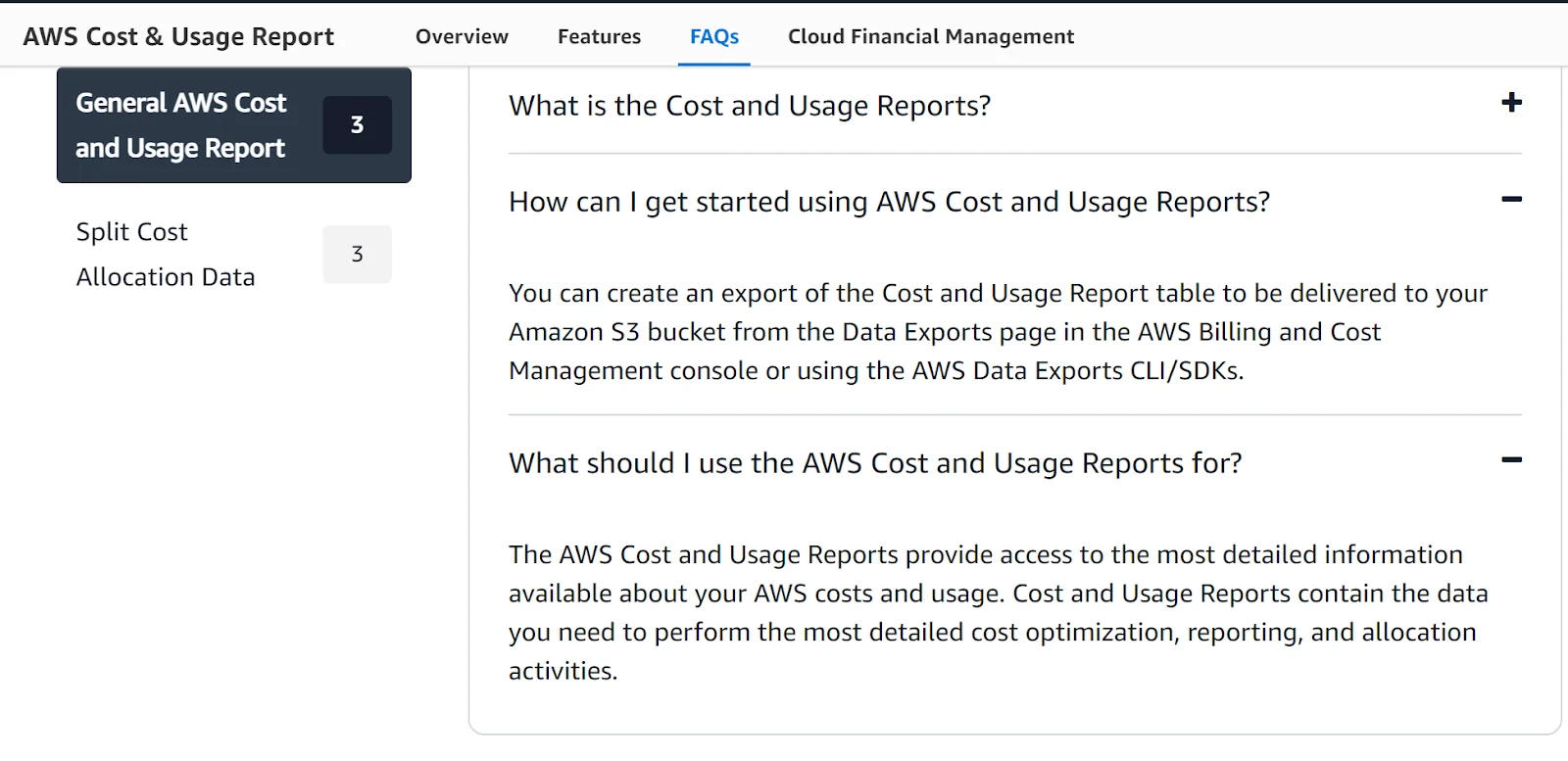
AWS Cost and Usage Reports provide detailed line item data for thorough analysis if Cost Explorer’s reports aren’t sufficient. You can generate custom reports in .csv format and have them ready for your team analysis in Amazon S3 within 24 hours.
With billing reports, the Cost and Usage Reports provide the basis for cost and usage analyses across AWS, such as those conducted with Cost Explorer, AWS Cost Categories, and AWS Budgets.
The reports are excellent for analyzing your cost drivers at the resource level. This way, you can tell where you may need to cut costs to prevent waste or find cost saving opportunities. Additionally, granularity enables you to track cost anomalies and understand how a particular resource or service is performing against cost projections.
21. AWS Budgets

AWS Budgets enables you to create custom budgets, track them using resource-level usage and cost data, and set spending limits. Some types of budgets you can create here include cost, usage, Reserved Instances (RI), RI coverage, RI utilization, Savings Plans utilization, and Savings Plans coverage budgets.
By setting custom alerts, Budgets lets you know when you are about to hit the spend limit, so you can intervene without causing downtime. Better yet, you can set custom actions to automatically trigger certain responses, enabling you to automate cost control.
AWS Budgets extends to forecasting. You can view your forecasted resource use and spend to help with proactive resource management. You can also set your preferred budget periods to daily, monthly, quarterly, or annually.
22. AWS Compute Optimizer
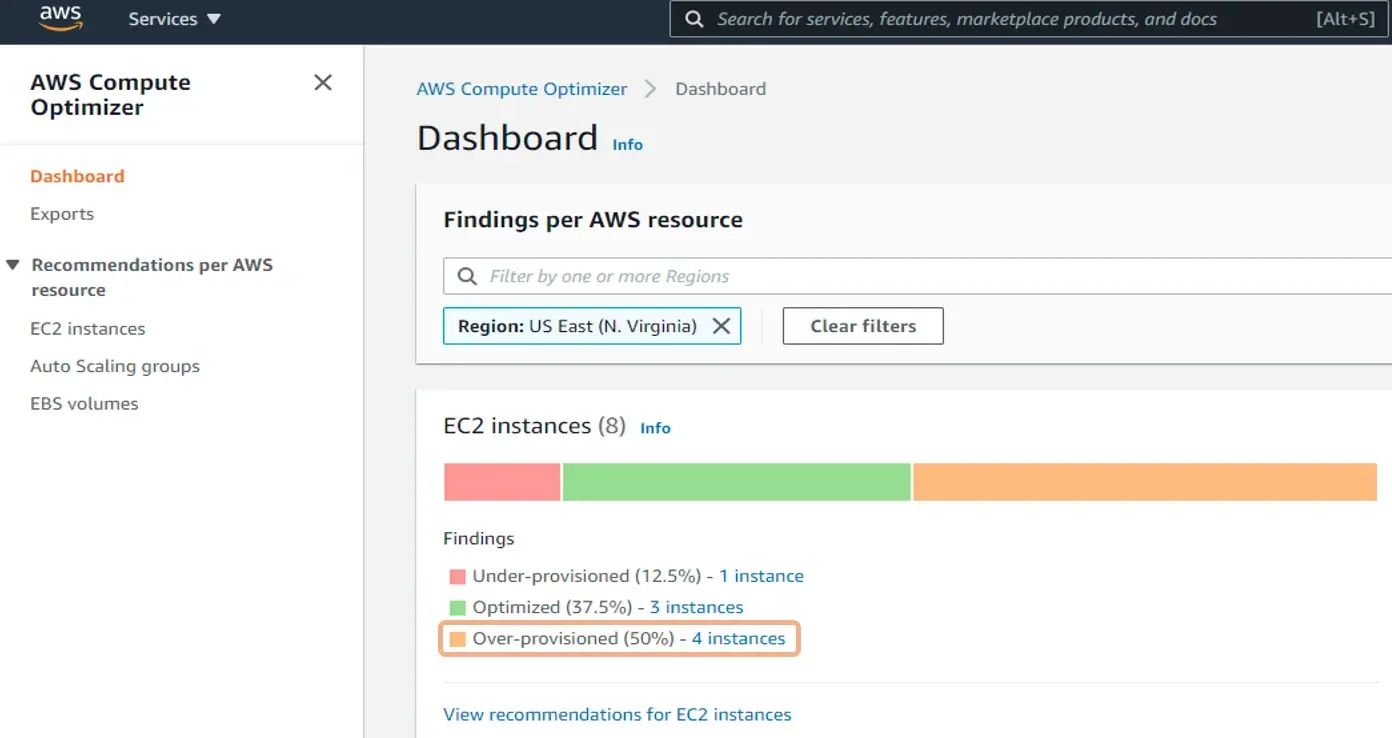
AWS Compute Optimizer uses machine learning to analyze AWS resource configurations and utilization metrics. It then provides optimization recommendations to help you balance performance and cost efficiency.
Compute Optimizer categorizes your resources as optimized, over-provisioned, or under-provisioned based on performance and cost. The tool covers Amazon EC2 instances, Auto Scaling groups, EBS volumes, Lambda functions, and ECS services on AWS Fargate.
The service also provides a cross-account view of your optimization opportunities. The recommendations are also accompanied by projected utilization graphs to help you decide whether they are worth implementing. All AWS customers can use AWS Compute Optimizer for no additional fees.
23. AWS Cost Anomaly Detection
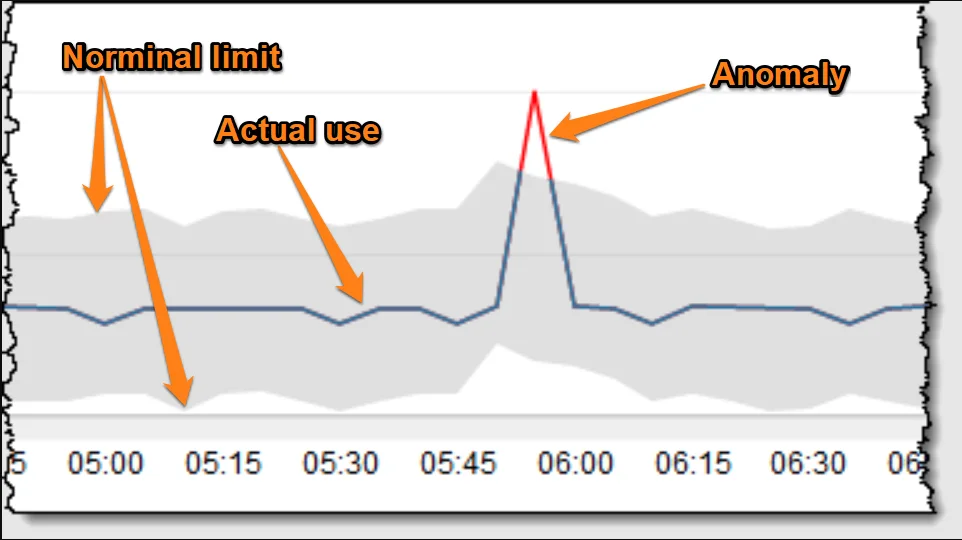
A key component of achieving FinOps goals is to prevent potential issues from becoming costly problems. With AWS Cost Anomaly Detection, you get a service that tracks your resource usage and spending patterns. It then detects unexpected cost spikes and variances from your typical spending.
You can set AWS Cost Anomaly Detection to alert you to unexpected cost changes. You can also combine this with a more robust cost anomaly detection platform for more precise alerting. This way, you can jump in to check if any issue raised could lead to overspending.
The tool also provides automated root cause analysis. This means you can pinpoint specific services or usage types responsible for these cost changes. By taking this proactive approach, your organization can better manage the financial risks associated with using the variable nature of cloud computing costs.
24. AWS Trusted Advisor
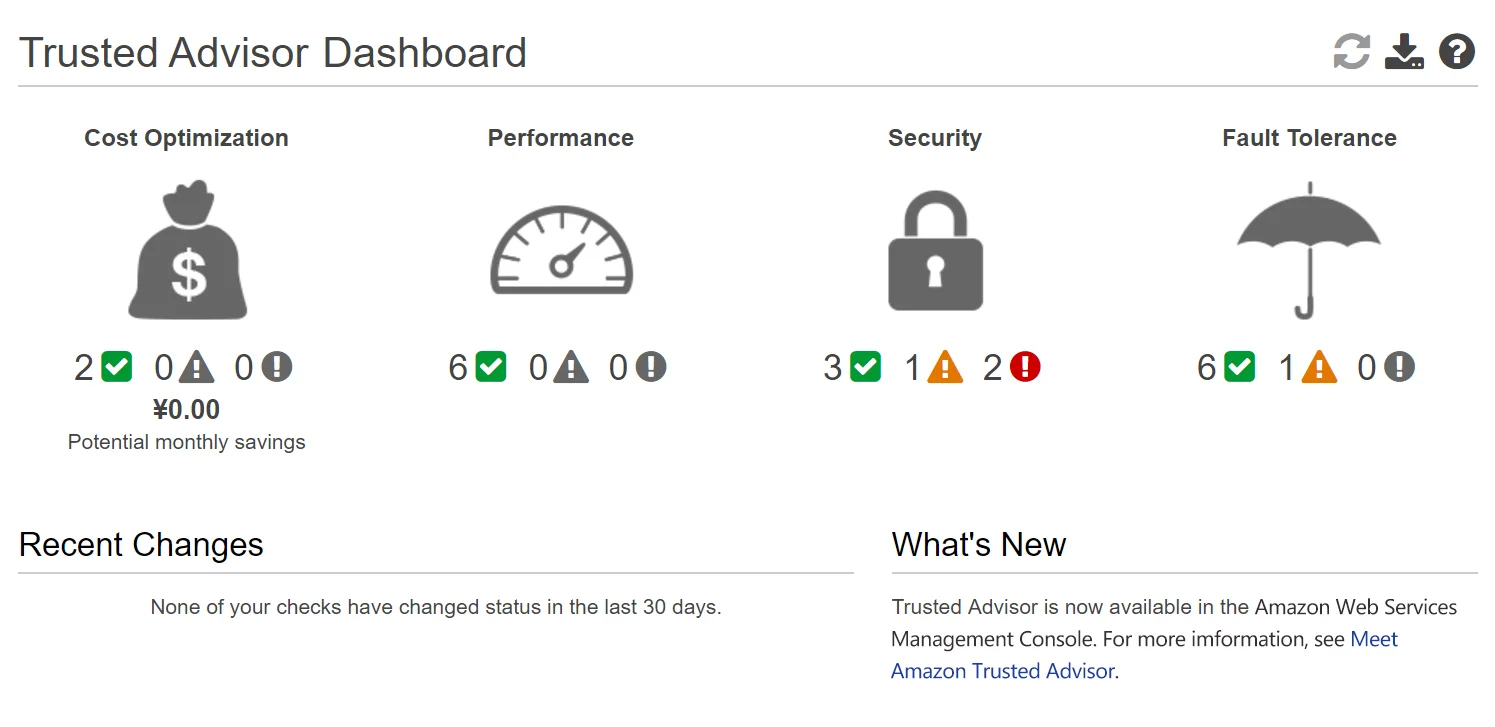
AWS Trusted Advisor scans your AWS environment for optimization gaps. It benchmarks your AWS environment against AWS best practice checks to identify issues.
Once it finds some, Trusted Advisor provides real-time recommendations across cloud cost optimization, security, resilience, service limits, operational, and performance excellence. Examples here include underutilized resources, such as idle Amazon RDS instances and unassociated Elastic IPs.
However, you decide whether you will use these recommendations in your environment.
Trusted Advisors also suggest ways to reduce long-term costs using Reserved Instances and Savings Plans. By highlighting opportunities for improvement, Trusted Advisor empowers organizations to reduce resource usage and save money.
Next, what happens if native FinOps services aren’t providing you with the AWS cost insights you need?
Best Third-party AWS Tools For FinOps Teams
If you only need overviews or don’t have a lot of data to deal with, native AWS FinOps tools are handy. But if you need more in-depth cloud cost intelligence, consider the following alternatives.
25. CloudZero

CloudZero isn’t the typical cloud cost management tool for several reasons:
- Cloud cost intelligence approach: CloudZero ingests AWS cost data like an observability tool (unlike conventional cost tools). It enriches this data and turns it into bite-size cost insights you can apply immediately.
- No cost allocation tags are required: CloudZero leverages more than your tags to deliver complete and accurate cloud cost intelligence. Even if you have messy tags, you still get immediately actionable intel on your tagged, untagged, and untaggable resources.
- Unit cost insights: CloudZero is the first cloud FinOps platform to offer high-level and granular insights into AWS cloud costs across all dimensions. Examples here include Cost per Customer, Cost per Service, Cost per Team, and Cost per Product feature. Expect this same level of precision for the costs of shared resources in multi-tenant environments.
- Real-time cost allocation: CloudZero also allocates 100% of your AWS costs in minutes, enabling you to respond quickly to changing conditions.
- Hourly granularity: You won’t need to wait for a once-in-24-hours report to catch an issue before it becomes costly.
- Smart alerts: CloudZero’s real-time cost anomaly detection delivers timely, contextual, and noise-free alerts to help prevent budget overruns on your terms.
- Single pane of truth: With CloudZero, you get a comprehensive view of your cloud costs, regardless of whether you use AWS exclusively or plan to adopt a hybrid cloud setup in the future. You won’t need multiple cost tools anymore.
- Personalized FinOps guidance: CloudZero account managers are FinOps certified professionals. And they are on hand for ongoing consultations so you won’t need to rely on auto-generated recommendations.
- Proven track record: CloudZero customers trust us with more than $5 billion under management, and say, on average, CloudZero pays for itself within three months. On average, they had 22% more savings compared to using traditional cost management.
Don’t just take our word for it.  to experience CloudZero firsthand. It’s free and you’ll be up and running in minutes.
to experience CloudZero firsthand. It’s free and you’ll be up and running in minutes.
26. ProsperOps
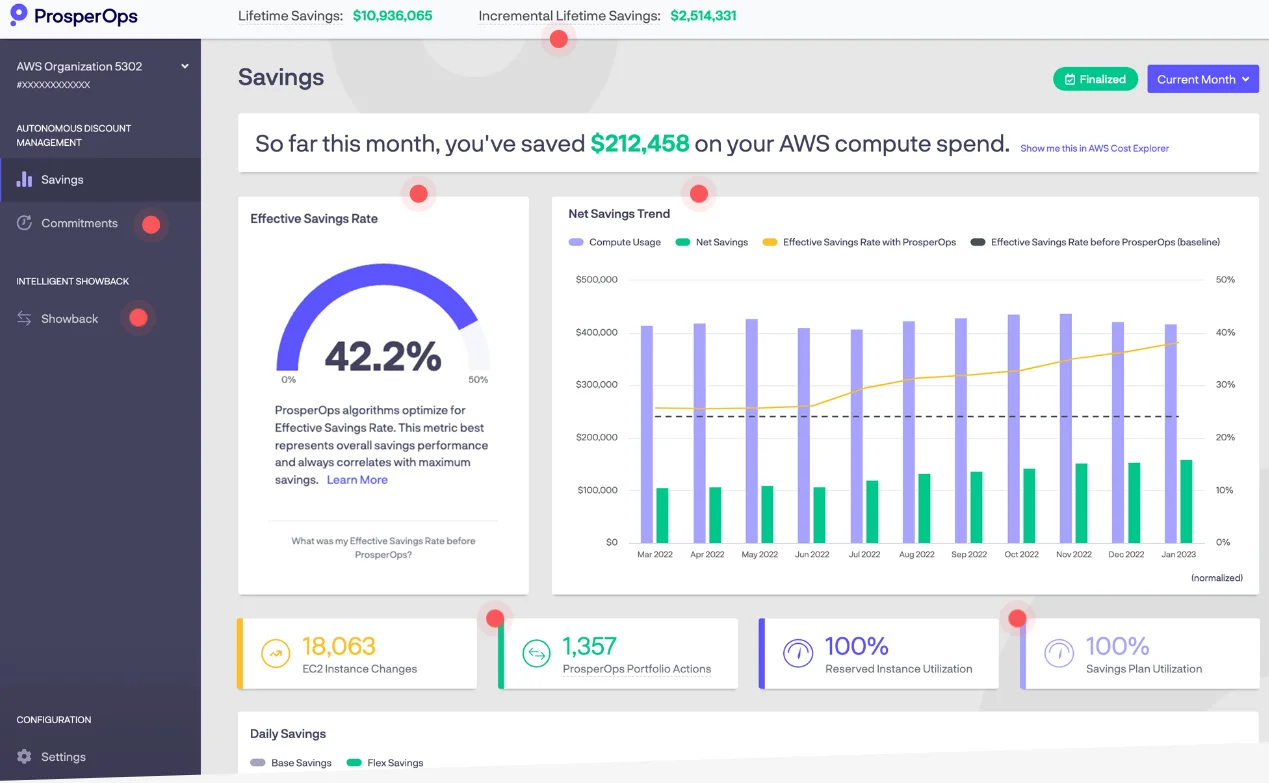
ProsperOps automates AWS cloud cost optimization by programmatically optimizing Reserved Instances (RIs) and Savings Plans. It uses AI and machine learning to analyze real-time usage data, how to maximize savings, and when to minimize commitment risks.
The platform helps you manage discount instruments, such as AWS Savings Plans and Reserved Instances, without ongoing human intervention. The goal here is optimal coverage and utilization.
ProsperOps will continuously adjust your commitments based on changing workloads. This helps your FinOps team focus on maximizing AWS cloud ROI rather than manual cost management tasks.
Additionally, CloudZero customers get a complimentary discounts optimization dashboard right within their account. No need to log into different accounts to optimize your SPs and RIs for maximum ROI.
27. Xosphere
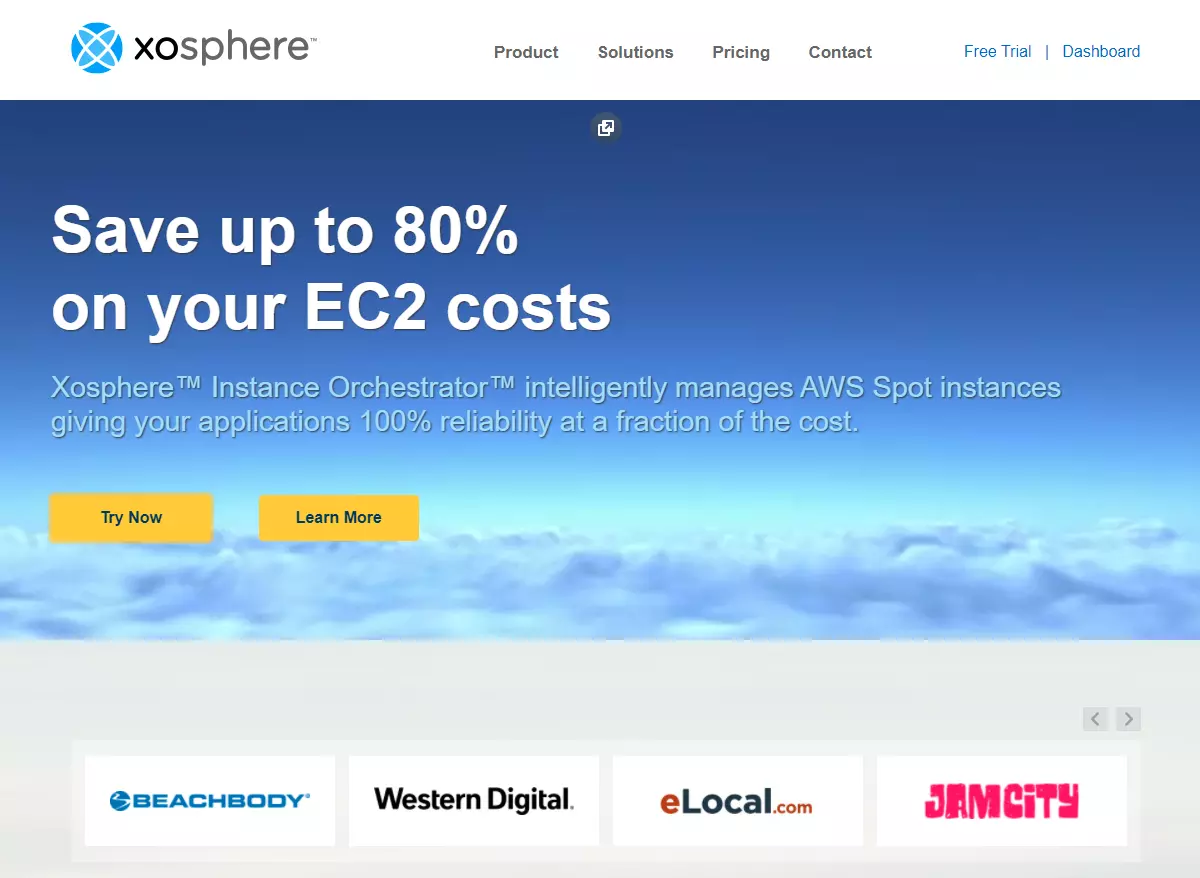
Perhaps you’ve explored how AWS Spot Instances can help to reduce your AWS compute costs. And, as you probably noticed, it can be quite a hassle to bid for the best Spot price and still have to switch workloads to other instance types when the Spot price becomes unfavorable.
The fact that AWS only gives two minutes’ notice when it needs the Spot capacity back doesn’t help either.
With Xosphere, you can automate all of those tasks and more to take full advantage of cheap AWS Spot instances. FinOps teams use Xosphere to orchestrate Spot instances based on the Spot price, automatically switching your workload to and from On-Demand instances for the most significant cost savings without downtime.
Xosphere also works with containers across Amazon ECS, Amazon EKS, Rancher, Kubernetes, and Mesos, as well as a variety of SQL and NoSQL datastores.
28. Zesty
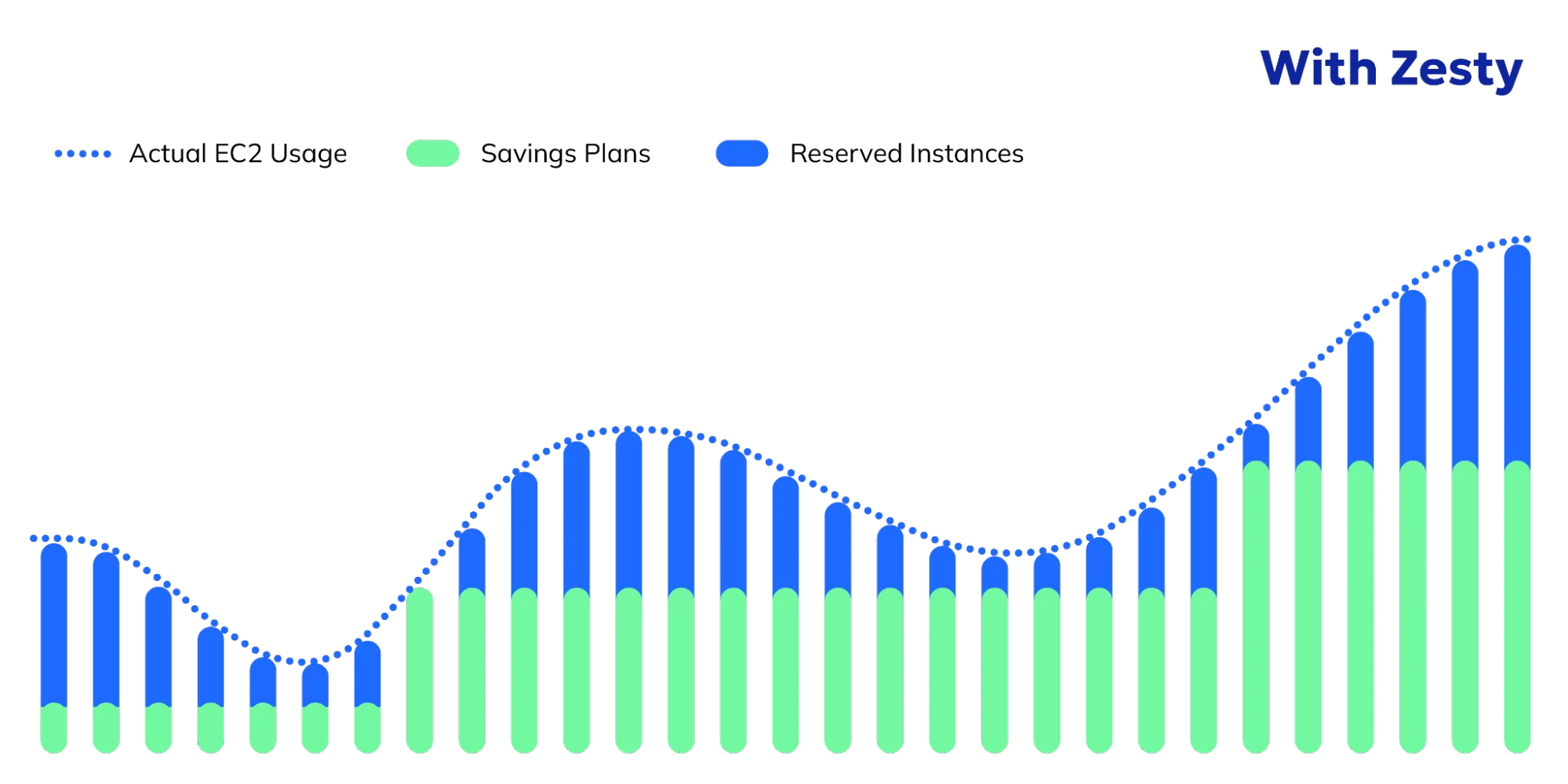
Zesty promises a FinOps automation experience by covering three bases (no code changes required). It automates Amazon EC2 and RDS commitment discount management. Commitment Manager helps you do this by dynamically adjusting your AWS Reserved Instances based on real-time needs in your environment.
With Zesty Disk, you can automatically scale storage resources to match your app’s demand. Meanwhile, prescriptive insights help power the AI-driven automation with minimal on-call requests, further minimizing costs.
29. Finout
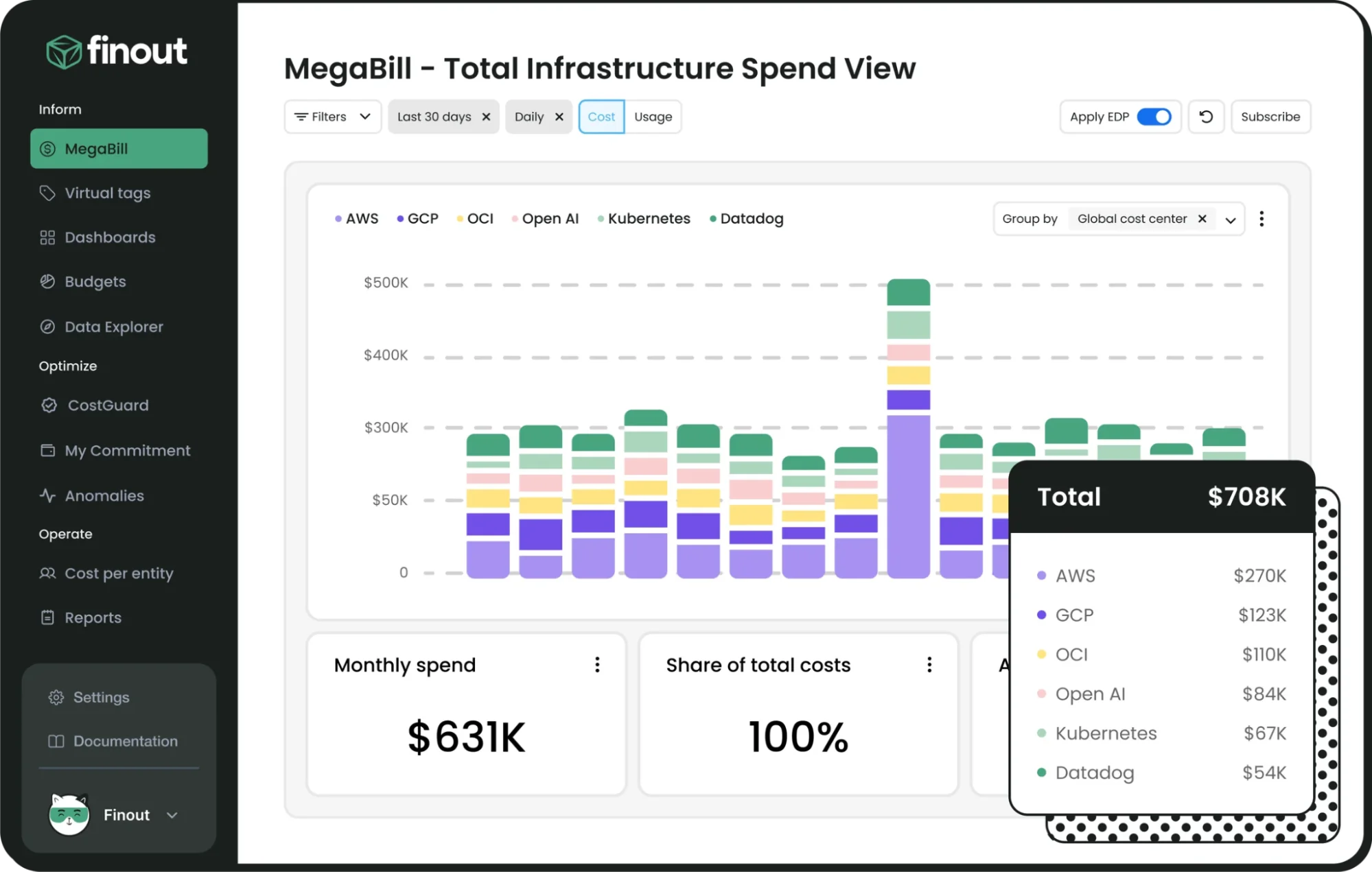
FinOut promises to help financial operations teams optimize their systems’ performance in line with the FinOps framework. It aggregates data from multiple platforms, helping you increase cost visibility within cloud and SaaS setups.
Key FinOut features include real-time monitoring, analytics, and a unique virtual tagging system that can help you identify waste and allocate costs more effectively.
FinOut’s dashboards translate technical costs into business metrics. This is great for connecting cost data to productive communication and decisions between finance and engineering teams.
30. CloudHealth
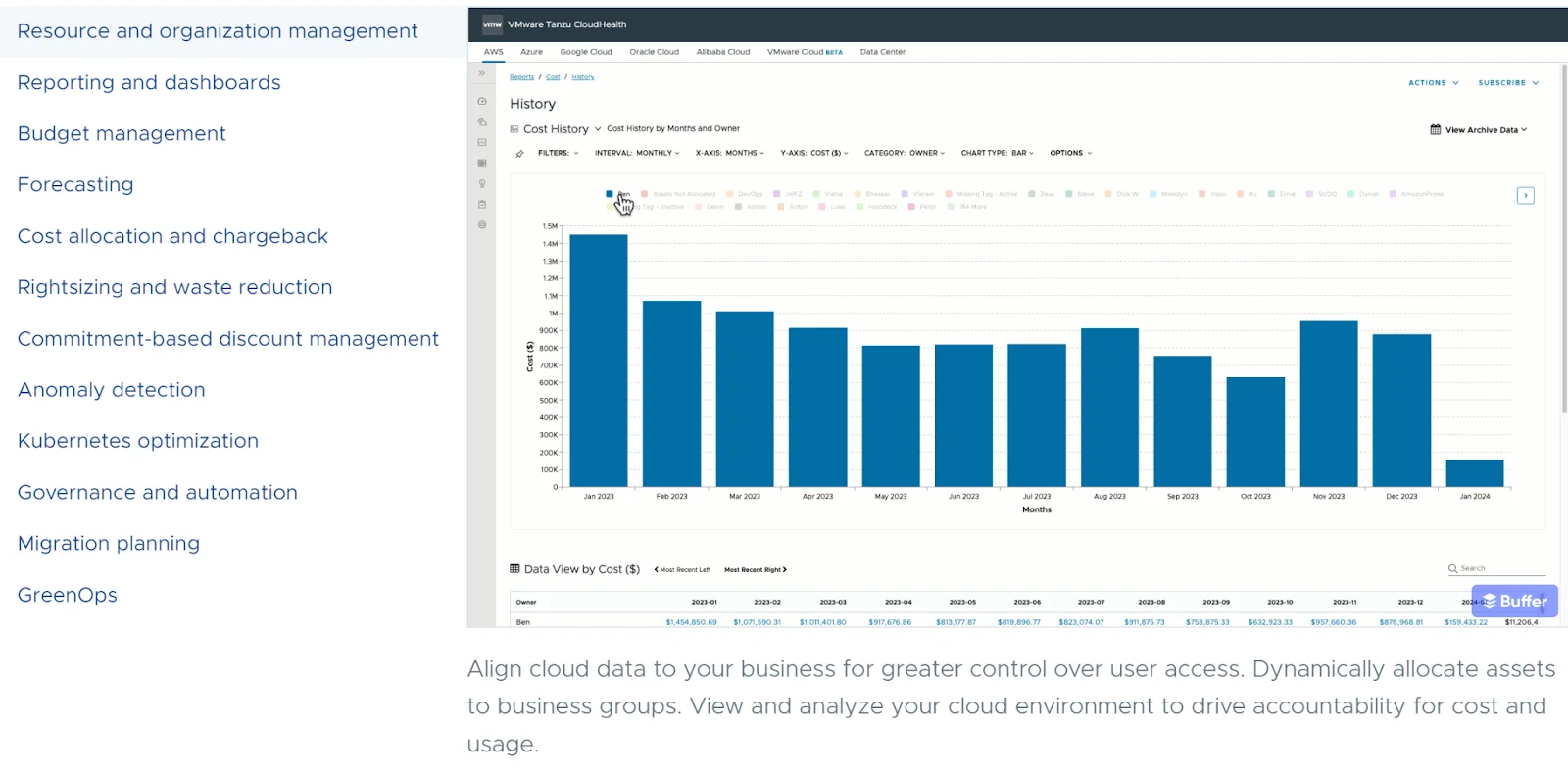
CloudHealth focuses on traditional cloud cost optimization methods and financial operations. Rightsize resources, terminate idle or unused resources, and use tags to track costs and usage across your infrastructure are a few examples here.
Also, the platform displays cost data by standard views such as business unit, project, team, and service. However, it places an emphasis on security and compliance. This can help you track issues that could lead to performance bottlenecks and overspending.
How To Manage, View, and Optimize AWS Cloud Costs From a Single Tool
Here is the thing. The majority of tools are either this or that. Consider the AWS tools we discussed here. In most cases, they are either great for engineers (DevOps) or for finance (cloud cost management).
The perennial problem has been that engineers rarely get involved in financial decisions. Yet they create the products and services, knowing how they work at the architectural level.
As a result, the isolation leads engineers to be unconscious of the financial impact their technical decisions have on the bottom line, competitiveness, and financial health of the organization.
But when empowered with the right cloud cost intelligence, engineers can be the first line of defence against cloud cost chaos. So, how do you do that?
CloudZero talks FinOps in the language engineers, finance, and FinOps can understand
CloudZero’s Engineering-Led Optimization (EOL) approach empowers:
- Engineering: Understand cloud costs in their own terms, including cost per deployment, cost per request, and cost per product feature. Combined with CloudZero’s real-time cost allocation, your engineers can tell what impact their technical decisions have on finances so they can stop overspending at the architectural level.
- Finance: Truly understand the cost of goods sold with immediately actionable insights, such as cost per customer and cost per product. This can help you set fair yet profitable pricing that sets you ahead of the competition.
- FinOps: Get the AWS cost intelligence you need for 100% cost allocation and predictive analysis to maximize your cloud ROI.
No matter where you are in the FinOps maturity journey, CloudZero will meet you there. A burgeoning startup or sprawling enterprises? CloudZero delivers detailed cost insights without overwhelming you. And our customers, like Remitly, MalwareBytes, and Shutterstock, agree. With CloudZero, Drift has saved over $2.4 million. Here’s your risk-free chance, too.  to experience CloudZero yourself.
to experience CloudZero yourself.

